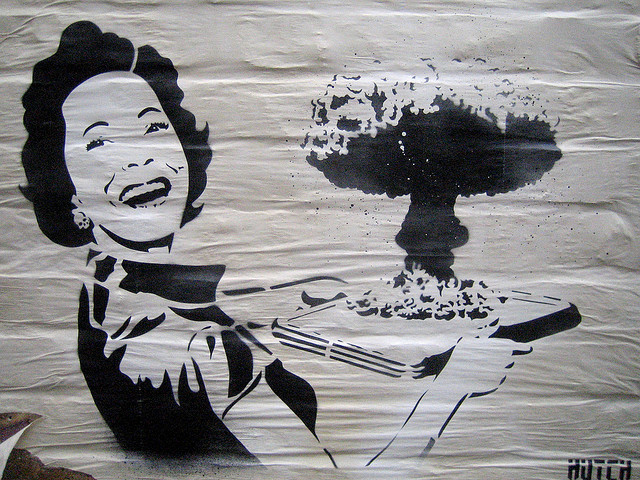Nuclear disarmament – all in good time
Posted By Michael O'Hanlon on March 20, 2013 @ 05:00
 [1]What of the issue of nuclear deterrence in the US–Australia alliance, and more generally in the western Pacific region?
[1]What of the issue of nuclear deterrence in the US–Australia alliance, and more generally in the western Pacific region?
For some, in America as well as Australia and elsewhere, this is chiefly a matter of moving as fast as possible to a nuclear-free world, in keeping with the hortatory goals of the Nuclear Non-Proliferation Treaty as well as President Obama’s Prague speech [2] of April 2009. For others, the problem is almost exactly the opposite. The real dilemma is ensuring continued nuclear deterrence as proliferation continues in places like North Korea, and China, India, and Pakistan continue to modernise or enlarge their arsenals.
More specifically, members of the so-called Global Zero movement often aspire to a time line in which negotiations on a treaty would begin within ten years, with the global elimination of nuclear weapons ideally to occur by 2030 or 2035. On the other side of the coin, many foreign policy pragmatists and traditionalists are content to imagine a nuclear-free world as a worthy goal but see absolutely no way to contemplate it at this moment in history.
In fact, a middle ground between these positions makes the most sense. Moving to nuclear disarmament now, by trying to write a treaty in the next few years, is too fast, but waiting for the distant future is too slow. I believe that Global Zero’s goal of a relatively near-term nuclear-free world, and a treaty process associated with it, risks being counterproductive and even dangerous. Yet the movement’s view that the elimination of nuclear weapons is a goal worth taking seriously is correct, if approached in a wise and patient way.
Trying to abolish nuclear weapons too soon could undercut the confidence of US allies, who rely on Washington’s extended deterrence to ensure their security in a dangerous world. And it could encourage extremist states to build up nuclear arsenals as existing nuclear powers build down. It also lacks credibility in a world in which even some responsible countries have no interest in denuclearising anytime soon. Absent a serious process for moving toward zero, declaration of ambitious but arbitrary and unattainable deadlines for action is more likely to discredit the nuclear disarmament agenda than to advance it [3]. Putting off the nuclear disarmament agenda creates its own substantial problems, however. It leaves existing nuclear powers in a weak position to pressure would-be proliferators to abstain from the pursuit of nuclear weapons by perpetuating the perception of a permanent double standard in who gets to own the bomb. It risks damaging the global political consensus in support of the NPT and other nuclear safety and security efforts. It also fosters a false sense of safety and complacency about the supposed safety of living with the bomb.
Furthermore, the idea of some that America should deepen or highlight its nuclear commitments in Asia is not a good one on balance. It risks making much more dangerous any crises, with China in particular, over issues that, while serious, are not and should not be seen as existential. Disputes over islands and resources in the South China Sea and East China Sea are not appropriate stakes over which nuclear threats should be issued, for example. America’s nuclear arsenal remains safe, reliable, flexible, and quite capable for purposes of regional deterrence. Highlighting its role more vocally risks not only more dangerous crises, but the possibility that China in particular will decide to build up its arsenal so as to compete with America in this domain. That would be regrettable, and dangerous. For all these reasons, nuclear deterrence is not in need of reinvigoration or greater prominence in American regional security policy. An occasional reminder of the nature of America’s existing mutual defence treaties in the region may be useful—in language that is discreet but that leaves no doubt that US nuclear deterrence remains operative.
The timing of a nuclear disarmament agenda should not be set to a calendar. Rather, the right time horizon for seriously pushing a new nuclear accord is after we have resolved most of the world’s half dozen or so major territorial and existential issues involving major powers (Barry M. Blechman makes a similar argument here [4]). These issues include the status of Taiwan, a comprehensive Middle East peace and the issue of Kashmir. (Nuclear crises involving Iran and North Korea also need to be addressed, although the beginnings of a move toward nuclear disarmament might not have to await their complete resolution.) Then the plausibility of great power war over any imaginable issue that one can identify today would be very low. That in turn would make the basic structure and functioning of the international political system stable enough to take the risk of moving toward a nuclear-free world—a process that would be so radical as to be inherently destabilising in some sense and thus prudent to pursue only when the great powers are in a cooperative mode and undivided by irredentist territorial issues. With luck, most of those issues could be successfully addressed in the next couple of decades. But we cannot know that yet.
Michael O’Hanlon is a senior fellow with the Center for 21st Century Security and Intelligence and director of research for the foreign policy program at the Brookings Institution. Image courtesy of Flickr user Dr Case [5].
Article printed from The Strategist: https://www.aspistrategist.org.au
URL to article: https://www.aspistrategist.org.au/nuclear-disarmament-all-in-good-time/
URLs in this post:
[1] Image: http://www.aspistrategist.org.au/wp-content/uploads/2013/03/2944820942_c41c9d21ea_z.jpg
[2] Prague speech: http://www.huffingtonpost.com/2009/04/05/obama-prague-speech-on-nu_n_183219.html
[3] more likely to discredit the nuclear disarmament agenda than to advance it: http://www.sup.org/book.cgi?id=16866
[4] here: http://www.amazon.com/Elements-Nuclear-Disarmament-Treaty-Editor/dp/0982193572
[5] Dr Case: http://www.flickr.com/photos/justin_case/2944820942/
Click here to print.